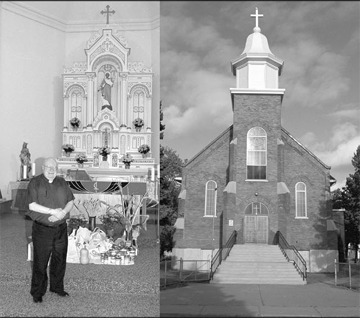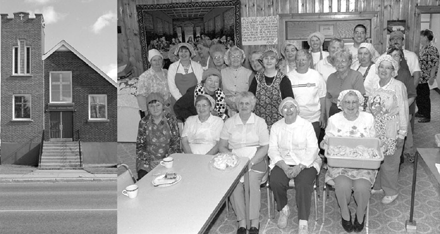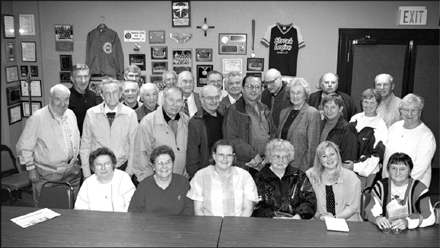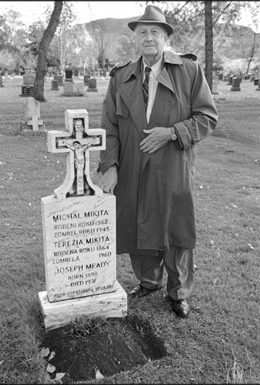|
|
 |
 |
|
Todays Slovaks of Thunder Bay
|
 |
 |
 |
|
By Ondrej Mihal
with Angela Meady
|
|
|
|
Within the scope of research of the history of Slovaks in Canada it is a known fact that the first Slovaks came to today's Thunder Bay almost 120 years ago. The Slovaks of this city, including some 3rd or 4th generation Slovaks of the original immigrants, are very eager and proud to participate with the Slovaks in Canada Exhibit, scheduled for the summer of 2002 in Bratislava. There are today, still numerous Slovak organizations in Thunder Bay. Yes, the years have taken their tole on the numbers, but what they lack in numbers they more than make up in both co-operation and desire to make their history known to everyone in Slovakia.
|
|
|
 |
 |
|
Flying in on a Boeing 767 Airplane to Thunder Bay Airport, one can quickly see the beauty of the surrounding country side, beautifully coloured by the early fall colours of the indigenous white birch trees and appreciate the vastness of greater Thunder Bay. From the air one can see that the city today stretches for miles in each direction from the lake; which was and still is its historical heart. But the original Slovaks who came to the northern shores of Lake Superior, the largest of the Great Lakes came originally to two distinct towns called Fort William and Port Arthur.
|
 |
 |
 |
 |
|
 |
 |
 |
|
 |
|
|
|
The precise date of Slovak immigration to this area is known through oral tradition rather than documentation but there are records of a Slovak presence in the town of Port Arthur as early as 1885. Jan Podbielancik was a Slovak who spoke English and along with his fellow Slovaks from the Orava district of what was then Hungary, he was among the first wave of Slovaks to come to the area. They were attracted to the opportunities for work presented by the CPR which was built at that time, and the related industries of grain handling, dock loading, coal handling and the like. As early as 1901, they formed the first organization of Slovak Canadians when they joined the Sv. Votecha Society with the guidance of Rev. Josef Pauco a compatriot from Orava who was invited from Scranton, Pennsylvania to lead them in a mission. In the 1901 census for Fort Willaim there are hundreds of Slovak names. In these early days they worshipped at the Port Arthur English church of St. Andrews and later moved (with the CPR) to Fort William and Island No. 1 where they shared a Mission church with the native Ojibwe indians; later still at the English church of St. Patricks. Here, the Jesuit priests were impressed with their faith and their zeal to have a church of their own and they were assisted in the building of St. Peter's Church, a church which celebrated its 90th anniversary in 1998 and which I filmed during my visit. The original Stations of the Cross in Slovak are still there.Their first priest, Rev. Francis Maynard S.J., ordered them made for the church's opening in 1908 because his Bishop had predicted that the Slovaks would quickly become assimilated into the Canadian culture and no longer need Slovak services - they still are part of the active faith life of the church and stand testament to the love the French priest had for his Slovak flock whom he called "good, generous and devoted people."
|
|
|
 |
|
|
Also in the city is the Trinity Lutheran Church which represents the first Slovak Lutheran congregation founded in Canada (1927). Before they could build their church they held services in local homes and Scandinavian churches. Many descendants are still there and proud of their history. Fort William was a very early organized community, forming eleven organizations in the first part of the century - from the First Catholic Slovak Union in 1902, through the Slovak Evangelical Union in 1927, the Canadian Slovak League in 1936, the Royal Canadian Slovak Legion in 1936 and multiple others. They had the earliest orchestras and gymnastic societies, literary and cultural organizations in the country and prior to the 1940s were the biggest group of Slovaks living in Canada.
|
|
|
 |
|
|
There were four distinct waves of immigration to the city - prior to 1900, the 1920s, the after-war period and after 1968. Immigration has been slower in recent years but it is still a community which remembers it roots - witness the grand 100th anniversary of Slovak immigration to Thunder Bay celebrations held in 1985 and the erection of a monument to the memory of those forefathers in 1988. It is a city where pirohy are a hot commodity, fourth generation children know how to best ask dedko for penazi, most everyone knows at least the first verse of Hej Slovaci, Slovak hymns are still sung for special occasions and everyone has an amazing historical photo or two in their personal collection, not to mention a proud memory of their forebearers which they will recount to someone who is interested.
The primary purpose of my visit to Thunder Bay was to give a first hand explanation of the mandate of the Slovaks in Canada Exhibit to as many organizations as possible,. A meeting was organized by Slovak community leader Peter Suffak. The face-to-face meeting with the various interested parties was beneficial for input, answering questions and for discussing progress as well as achievements to date . The presentation was held at the Slovak Legion Board Room and the meeting was attended by over 30 Slovak community leaders and interested parties (Louis Bystrican, Olga Bystrican, Joseph Cisarak, Peppy Dika, Jakob Filicko, Teresa Furik, Tom Gvora, Mrs. Haberen, Andrej Humenaj, Joseph and Mrs. Kacerik, Irene Lauro, Ludovit Lauro, Apollonia Leonard, Joe Liba, Angela Meady, William Meady, Cecilia Pero, Susan Petrovic, Magda Pimenow, Steve Potosky, Jane Slobodnik, John Soychak, Joe Spavor, Peter Suffak, Klara Verescak, Mike Verescak and Peter Zack).
|
|
|
 |
|
|
The rest of the visit was more focused and allowed Peter Suffak, Angela Meady and myself to concentrate on gathering of materials such as old books and calendars from St. Peters Catholic Church, old photographs and minute books from the local chapters of the Jednota and Canadian Slovak League, old photographs from the family of Angela Meady, Peter Suffak, Magda Pimenow, David Rak and Trinity Lutheran Church, as well as original documents from David Verescak and Stephen Potosky. Many more organizations and individuals have promised to work with Peter Suffak and Angela Meady "now that they are convinced that the project will be successful ". To those that have to date contributed material, the organizing committee is very grateful, and for those that are still wondering if they should help, now is a good time to help; and it is certain that Angela and Peter would welcome their contributions.
The trip was also an opportunity for me to shoot some original photographs of Slovak historical significance. The most obvious was a visit to the oldest Slovak cemetery headstones that are found at St. Patrick's cemetery. In addition, details of the old Slovak neighbourhood of Fort William were photographed. To this day one can find some of the original Slovak houses built almost 100 years ago. In addition, the trip allowed me to video tape background material of the various locations of Slovak interest for the upcoming "Slovaks in Canada" video that is in pre-production.
|
|
|
 |
|
|
|
Many thanks go to Angela Meady, Peter Suffak and William Meady for their dedication to making sure that I covered all the necessary bases in the four days of my visit to Thunder Bay and including some scenic side trips to Kakabeka Falls, the "Niagara of the North" and the Mission church on the Native reserve where many of the first Slovak immigrants worshipped. The visit also allowed us to observe the making of the traditional "Slovak pirohy" at Trinity Lutheran Church, which are sold to the local community and are found in many restaurants and homes throughout Thunder Bay. The Meady (Mikita) family themselves, have been in Thunder Bay for over 100 years. The trip was a complete success and my return trip to Toronto was weighed down by over 50 KG of historical photographs, books, calendars, an 80 year old Krivan Folklore costume and other materials that are destined for the Exhibit in Slovakia.
|
|
|
[Previous Article] [List of New Articles] [Next Article]
|
|
|
|
[SliC Project] [Overview] [Member Orgs] [New Articles]
[Archived Articles] [Help Us]
|
|



